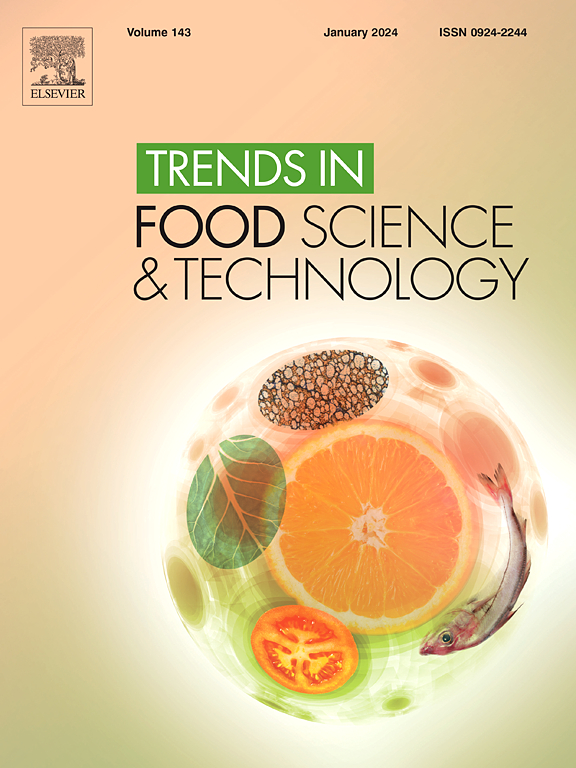Systematic review on functional umami peptides: Physiological perceptions, bioinformatics and peptidomics approaches, developments and applications
IF 15.1
1区 农林科学
Q1 FOOD SCIENCE & TECHNOLOGY
引用次数: 0
Abstract
Background
Given the unique sensory attributes and potential health benefits of functional umami peptides (FUPs), they have emerged as a focal point in food science research. However, challenges remain in their taste perception mechanism elucidation and discovery, thereby highlight the necessity of interdisciplinary integration, particularly with advanced fields such as peptidomics and metagenomics, to deepen our understanding of FUPs and accelerate their identification and functional characterization.
Scope and approach
This paper begins by reviewing recent progress on the taste perception mechanisms and key influencing factors of FUPs. It then summarizes the latest advancements in high-throughput FUPs discovery, driven by cutting-edge technologies including bioinformatics, metagenomics, protein engineering and peptidomics. Finally, an elaboration is provided on the current applications of FUPs in the food industry, along with an anticipation of potential future development trajectories.
Key findings and conclusions
Umami receptors are activated through dynamic binding-dissociation interactions with FUPs, with their conformational changes governed by either a stepwise activation model or an orthosteric-allosteric cooperative mechanism. The resultant neural signals undergo gustatory encoding via peripheral-central neural pathways. This sensory processing is collectively modulated by nonlinear cross-modal perceptual characteristics and physicochemical parameters within food matrices, including ionic, pH, and temperature. Integrated peptidomics elucidates the global peptide repertoire for further unraveling and consummating the above mechanisms, while microbial-proteomic multi-omics integration establishes a novel paradigm for targeted FUPs biosynthesis. Therefore, the integration of cross-disciplinary technologies will accelerate the discovery and rational design of novel FUPs, hence driving their scalable applications in flavor enhancers and functional ingredients industries.
功能性鲜味肽的系统综述:生理感知、生物信息学和肽组学方法、发展和应用
鉴于功能性鲜味肽独特的感官属性和潜在的健康益处,它们已成为食品科学研究的焦点。然而,在其味觉机制的阐明和发现方面仍然存在挑战,因此突出了跨学科整合的必要性,特别是与肽组学和宏基因组学等先进领域的整合,以加深我们对ffp的理解,加速其鉴定和功能表征。本文首先综述了近年来在味觉感知机制和关键影响因素方面的研究进展。然后总结了在生物信息学、宏基因组学、蛋白质工程和肽组学等前沿技术的推动下,高通量ffp发现的最新进展。最后,详细介绍了目前在食品工业中的应用,以及对未来潜在发展轨迹的预测。sumami受体通过与fps的动态结合-解离相互作用被激活,其构象变化受逐步激活模型或正构-变构协同机制的控制。由此产生的神经信号通过外周-中枢神经通路进行味觉编码。这种感觉加工是由非线性跨模态感知特征和食物基质中的物理化学参数(包括离子、pH和温度)共同调节的。整合肽组学为进一步揭示和完善上述机制阐明了全局肽库,而微生物-蛋白质组学多组学整合为靶向fps生物合成建立了新的范例。因此,跨学科技术的整合将加速新型ffp的发现和合理设计,从而推动其在风味增强剂和功能配料行业的可扩展应用。
本文章由计算机程序翻译,如有差异,请以英文原文为准。
求助全文
约1分钟内获得全文
求助全文
来源期刊

Trends in Food Science & Technology
工程技术-食品科技
CiteScore
32.50
自引率
2.60%
发文量
322
审稿时长
37 days
期刊介绍:
Trends in Food Science & Technology is a prestigious international journal that specializes in peer-reviewed articles covering the latest advancements in technology, food science, and human nutrition. It serves as a bridge between specialized primary journals and general trade magazines, providing readable and scientifically rigorous reviews and commentaries on current research developments and their potential applications in the food industry.
Unlike traditional journals, Trends in Food Science & Technology does not publish original research papers. Instead, it focuses on critical and comprehensive reviews to offer valuable insights for professionals in the field. By bringing together cutting-edge research and industry applications, this journal plays a vital role in disseminating knowledge and facilitating advancements in the food science and technology sector.
 求助内容:
求助内容: 应助结果提醒方式:
应助结果提醒方式:


